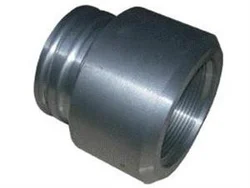Gray iron castings cast hard, what is the reason
Why Are Gray Iron Castings Hard?
Gray iron is one of the most commonly cast metals. It is a very inexpensive and easy to machine metal that is widely used for many applications.
It is characterized by the presence of graphite flakes in the microstructure. These flakes don't contribute any strength, but they do help the alloy absorb vibrations. They can also be a good lubricant for cuts and break up chips when machining.
The Graphite Flakes
Grey iron (also called cast iron) is the most common of all engineering alloys, and has been used in a wide range of automotive components including engine blocks, crank shafts and power-train heads. Gray iron is characterized by the presence of interconnected graphite flakes which solidify to form eutectic cells in the molten iron. The flakes are clustered like potato chips and each flake defines its own cell in the eutectic.
The morphology of the flakes can vary greatly depending on the cooling rate and the temperature at which the graphite flakes solidify. A high cooling rate results in primary graphite flakes in the austenite-graphite eutectic; whereas a low cooling rate results in secondary graphite flakes which accumulate around a fine supercooled graphite.
During the process of cooling, all cast metals are section sensitive, which means that as sections increase in size and thickness, the solidification rate decreases and the grain size increases. This affects the strength and hardness of the cast iron.
In gray iron, graphite flakes are the most prominent and dominant influencing factor on its mechanical properties. The conduit fittings act as stress raisers to cause localized plastic flow and fracture in the matrix at low stresses, and they also provide a self-lubricating and damping effect.
As a result of their importance, many foundries use controlled additions of elemental additives in their production of gray iron castings to refine the morphology of the graphite. These include a combination of elements such as manganese, sulfur, silicon and phosphorus.
The presence of these additives has a marked impact on the microstructure, properties and cost of the gray iron castings. These additions also have a direct effect on the machinability of the castings.
Another important characteristic of gray iron is the presence of nitrogen. This element is usually added as a charge material during the melting and pouring of the gray iron.
Nitrogen, when present in sufficient amounts, has been reported to improve the tensile strength of gray iron castings. In addition, it has been shown to promote the formation of pearlite in the graphite flakes. This enables improved ductility, toughness and elongation in the gray iron castings.

The Manganese
When a gray iron casting is poured into a mold it is essentially the same as any other iron molten cast, but during the cooling portion of the process the resulting material will undergo dramatic changes. As a result the hardness of the casting will vary depending on the materials melted together and the method used for casting.
One of the most important ingredients that makes gray iron castings cast hard is manganese. This element is found in nature but also sourced from mines and factories. It is primarily used in steelmaking and is an important alloying metal, improving its strength, workability, and resistance to wear.
It is often combined with other metals, like copper, nickel, and zinc, to form stainless steel. It is also used in glass making, fertilizers, and ceramics.
The most common way to obtain manganese is through natural sources such as ores and rock formations. This type of mining usually takes place in open pits using standard methods for overburden removal and ore extraction.
Another source of manganese is through the mining of polymetallic nodules on the ocean floor. These gi conduit pipe bender nodules are concretions that contain manganese and other elements. ome manganese ores are found in the United States as well.
Several industrial activities, such as burning fossil fuels and fertilizers, increase the concentration of manganese in the air and in water. It is also a major component of soils and dust particles.
It is also an essential nutrient for humans, helping to reduce inflammation associated with asthma and lung pleurisy as well as inflammatory bowel disease and psoriasis. It is also a good source of antioxidants called superoxide dismutase (SOD), which help to break down certain types of free radicals.
A high intake of manganese can increase bone density and lower blood sugar levels in people with diabetes. It also can be helpful in reducing the risk of seizures. While more research is needed, studies indicate that low manganese levels may contribute to seizure disorders.
The Sulfur
Sulfur is a relatively common element and can be found in many forms including meteorites, volcanic ash, hot springs, galena, gypsum, Epsom salts, and barite. It is also a key ingredient in black gunpowder, rubber vulcanization, the manufacture of insecticides and pharmaceuticals and in the preparation of sulfur compounds such as hydrogen sulfide and sulfuric acid.
The oxidation state of this element ranges from -2 to +6 and combines with almost every other element except for noble gases (which have a negative oxidation state). It is a non-metallic element that can be found in solid, liquid or gaseous forms at room temperature.
Sulfur occurs naturally in sulphide minerals such as pyrite, marcasite and stibnite. It is also produced commercially from underground deposits through the Frasch process where superheated water and steam are pumped underground to melt and collect the sulfide.
A major source of dietary sulfur is the group of vegetables known as allium. These include garlic, leeks, onions, scallions and shallots, and have been linked to benefits in cardiovascular health, bone health, blood sugar control and detoxification.
Another source is cruciferous vegetables such as broccoli, cauliflower, cabbage and kale. These have been shown to provide glucosinolates, which are rich in sulfur.
These glucosinolates help to protect cells from harmful oxygen free radicals and reduce inflammation in the body. They can also help to improve the immune system and lower cholesterol levels.
As well as reducing inflammation, glucosinolates can have anti-carcinogenic properties which are beneficial in helping to prevent certain cancers.
Sulfur is also used to produce nitrates such as nitrite, which are widely found in the environment and used in medicines. These nitrates are formed when nitrogen is decomposed into nitrogen dioxide and sulfuric acid.
Sulfur is a strong, durable and highly reactive metal that can be formed into various alloys with other elements. However, sulfur is not as ductile as some other elements, making it difficult to work with and requiring more specialized tools to process it. This is why it is important to choose the correct tool for your casting project.
The Silicon
Silicon is a chemical element that was first isolated in 1824 by Swedish chemist Jons Jacob Berzelius. The flexible pipe element is most commonly used in construction materials, as well as electronics such as transistors and computer chips. It is also used to make waterproofing systems and silicones.
When silicon is melted it produces two allotropes. One of these allotropes consists of shiny, grayish-black needle-like crystals, or flat plates, while the other is an amorphous brown powder.
In the crystalline form, silicon has an octahedral crystal structure similar to carbon. It is relatively hard and has a high melting point of about 2,570degF (1,410degC).

The other allotropes are not quite as hard as crystalline silicon but they are still hard enough to be brittle. They have a crystalline structure of octahedral molecules linked by two oxygen atoms each with four silicon atoms.
Both forms of silicon are referred to as metalloids, which means they have properties of both metals and non-metals. They are also able to bond with a variety of other elements to produce compounds with specific characteristics that are useful for practical applications.
Cast irons are generally produced from molten iron mixed with carbon and silicon in proportions of 2.5 to 4% and 1 to 3%, respectively. Other desired elements such as boron and zirconium may be added to the melt to enhance the casting's properties.
As a result of the presence of silicon, most gray iron castings are made with a microstructure of flake graphite and austenite in a transformed-austenite matrix. This microstructure is softer than that of iron carbide in a eutectic solution (Figure 3).
The tensile strength of this material is controlled by the graphite flakes that deflect passing cracks and initiate new cracks as the material breaks. This microstructure makes grey iron castings very machinable, making them ideal for cylinder heads and other machined parts.
The reason why these castings are called gray iron is because the graphite flakes give them a gray color when they are examined under a microscope. The size and shape of the graphite flakes determine the strength and other mechanical properties of the cast iron.
Comments
Post a Comment